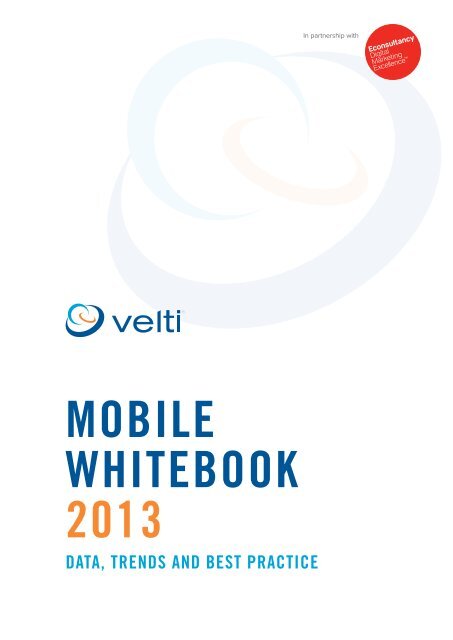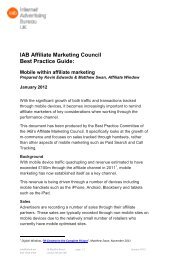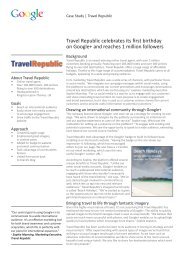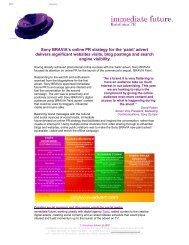Velti Mobile Whitebook 2013.pdf - IAB UK
Velti Mobile Whitebook 2013.pdf - IAB UK
Velti Mobile Whitebook 2013.pdf - IAB UK
You also want an ePaper? Increase the reach of your titles
YUMPU automatically turns print PDFs into web optimized ePapers that Google loves.
In partnership with<br />
<strong>Mobile</strong><br />
<strong>Whitebook</strong><br />
2013<br />
Data, trends and best practice
<strong>Mobile</strong> <strong>Whitebook</strong> 2013<br />
2<br />
www.velti.co.uk
<strong>Mobile</strong> <strong>Whitebook</strong> 2013<br />
Contents<br />
4 Introduction<br />
About <strong>Velti</strong><br />
6 Forewords<br />
From <strong>Velti</strong><br />
From Econsultancy<br />
7 Consumer Data: The Case for <strong>Mobile</strong><br />
8 <strong>Mobile</strong> penetration and use grows<br />
9 Tablets become the screen of choice<br />
10 Marketers need to cater for an multichannel world<br />
16 The Business Landscape<br />
20 Best Practice Advice<br />
21 Five steps to mobile success<br />
23 Measurement for mobile<br />
24 <strong>Mobile</strong> tactics for your marketing funnel<br />
25 Case Studies<br />
26 Vodafone Freebies<br />
26 Walkers Homegrown<br />
27 Samsung Hope Relay<br />
28 How <strong>Velti</strong> Can Help You<br />
28 Strategy in action<br />
www.velti.co.uk<br />
3
<strong>Mobile</strong> <strong>Whitebook</strong> 2013<br />
Introduction<br />
2013 ushers in a new age of consumer preference, consumer habits and<br />
consumer devices. The focus for marketers should be the same as it has<br />
always been, on the customer. <strong>Mobile</strong> marketing has made it through<br />
the Wild West and we are delighted to see positive and wide adoption<br />
in the industry.<br />
We have seen a surge of interest from brands investing time, thought<br />
and resources into their mobilisation efforts. Brands from all of our<br />
sectors have sought advice on mobile best practice, and due to the<br />
demand, we are delighted to share some of that expertise. Our research<br />
combines leading industry statistics, primary data and analytics from our<br />
own <strong>Velti</strong> platforms.<br />
To fully understand how the end consumers are using their devices, we<br />
are delighted to have partnered with <strong>Velti</strong>, the leading mobile marketing<br />
and advertising agency, to provide truly actionable insights to help you<br />
formulate an effective and accountable mobile strategy.<br />
4<br />
www.velti.co.uk
<strong>Mobile</strong> <strong>Whitebook</strong> 2013<br />
About <strong>Velti</strong><br />
<strong>Velti</strong> is the leading global provider of mobile marketing and advertising<br />
technology solutions that enable brands to implement highly targeted,<br />
interactive and measurable campaigns by communicating with and<br />
engaging consumers via their mobile devices.<br />
<strong>Velti</strong>’s experience in mobile spans all sectors and global regions, whilst<br />
their solutions cover the full end-to-end mobilisation journey, from initial<br />
activation to mobile customer acquisition through to retention strategies.<br />
They work with their clients to educate, optimise and inspire the use of<br />
the mobile channel and ultimately grow their revenues.<br />
Our clients include:<br />
Media<br />
Retail<br />
FMCG<br />
Finance<br />
and MNOs<br />
Gaming and<br />
Gambling<br />
Others<br />
www.velti.co.uk<br />
5
<strong>Mobile</strong> <strong>Whitebook</strong> 2013<br />
Forewords<br />
From <strong>Velti</strong><br />
As a business we aim to innovate, explore and<br />
share groundbreaking best practice to ensure that<br />
we help our clients capitalise efficiently on the<br />
mobile channel. The mobile landscape is complex<br />
and our team of dedicated strategic planners and<br />
analysts are committed to sharing both internal<br />
and external knowledge to advance your own<br />
marketing strategies in 2013.<br />
Just two in 10 of our sample* stated that they<br />
are 100% mobile, while a significant 45% of<br />
respondents stated that they need to do more or<br />
From Econsultancy<br />
Over the past few years, a cliché within marketing<br />
has been “This is the year of the mobile”, or more<br />
recently in a desperate plea for attention, “This year<br />
is really the year of the mobile”.<br />
In my opinion, such comments are not helpful.<br />
They present mobile as a transient consumer<br />
trend or fashionable term which can be dropped<br />
into conversation to win budgets and convince<br />
organisations to take action.<br />
The reality is that mobile is now already entrenched<br />
within consumer behaviours and decision making.<br />
Over half the population in the <strong>UK</strong> and the US<br />
own a smartphone and 65% of all online activities<br />
begin on a smartphone.1 With PC sales plummeting,<br />
don’t do anything on the channel. This means that<br />
there is still much work to be done in our industry<br />
to assist brands in their mobilisation efforts and<br />
revenue growth activities.<br />
We look forward to hearing about your plans and<br />
ideas for the channel of choice in 2013.<br />
Best Regards<br />
Barry Houlihan<br />
General Manager<br />
<strong>Velti</strong> Western Europe<br />
mobile devices are already the default way for<br />
most consumers to access and gain information on<br />
digital products and services.<br />
Despite this, the research revealed by <strong>Velti</strong> in this<br />
document shows that the majority of marketers are<br />
spending 5% or less of their efforts on mobile.<br />
I hope the data, insights and best practice tips<br />
presented in this document will spur you and your<br />
organisation to take action and take advantage<br />
of the opportunity presented by the new digital<br />
landscape.<br />
Andrew Warren-Payne<br />
Senior Research Analyst<br />
Econsultancy<br />
** http://services.google.com/fh/files/misc/multiscreenworld_final.pdf * 400 survey respondents randomly sampled<br />
and polled across all sectors in the <strong>UK</strong><br />
6 www.velti.co.uk
Consumer Data:<br />
The Case for <strong>Mobile</strong><br />
<strong>Mobile</strong> <strong>Whitebook</strong> 2013<br />
<strong>Mobile</strong> devices facilitate consumer interactions with your brand at<br />
any time or place convenient to them, and with over 14,000 different<br />
smart devices and tablets in use, interactions on the mobile channel<br />
are increasingly critical moments in the customer journey. Ensuring<br />
that these experiences remain positive should be at the centre of your<br />
mobile strategy.<br />
Consumer expectation has soared in recent years. Consumers now<br />
demand brands to be uniformly presented regardless of access points<br />
and oversight has meant many brands falling behind their full potential.<br />
The successful implementation of many brands’ mobile strategies<br />
(including Facebook and Amazon) has been a positive step in the right<br />
direction for the industry. However, despite undeniable adoption of<br />
smart devices by global consumers, marketers have been relatively<br />
slow to fully realise the potential of the opportunity presented. With<br />
the imminent rollout of 4G services, the ever-increasing presence of a<br />
variety of devices and screen sizes, Tablet, Phablet (ie. phones so large<br />
they are almost like tablets, such as the Samsung Galaxy Note) and<br />
even Laplets (Laptop/Tablet hybrids such as Windows Surface), it is vital<br />
to understand the role these devices play and how to best adapt your<br />
marketing strategy to become truly multi channel.<br />
The connected consumer now uses a variety of devices to research<br />
and complete even simpler purchases. They expect a great brand<br />
experience on every channel, platform or device, and they expect to be<br />
able to switch between them seamlessly. Anything less is a poor brand<br />
experience. Many brands state they have tried mobile but customers<br />
only use it to brand their product not purchase. Chances are<br />
what this really means is that most brands have not been<br />
optimised for mobile.<br />
www.velti.co.uk<br />
7
<strong>Mobile</strong> <strong>Whitebook</strong> 2013<br />
<strong>Mobile</strong> penetration and use grows<br />
<strong>Mobile</strong> devices have rapidly become an<br />
integral part of our everyday lives<br />
A recent survey by the insurer Endsleigh reports that 32% of us<br />
would be more willing to go without alcohol for a month than<br />
lose our mobile phone, with 24% of respondents believing that<br />
losing their phone would be detrimental to their mental health.<br />
Nielsen reports a 97% mobile phone penetration in the <strong>UK</strong>,<br />
with 64% of these being ‘smartphones’.<br />
A year ago, smartphone penetration in the <strong>UK</strong> tipped over the<br />
50% mark, making ownership irrefutably ‘mainstream’ for the<br />
first time. At the end of 2013, penetration levels were close to<br />
two-thirds of the population. That has changed the way brands<br />
can communicate.<br />
Smartphone use is a global phenomenon<br />
This phenomenon isn’t contained within the <strong>UK</strong>. Smartphone<br />
penetration in the EU5 has crossed over into the mainstream<br />
at 57%, which is higher than the respective penetration rate<br />
of the United States (54%). Meanwhile, rates are lower in<br />
Germany (51%) and Italy (53%).<br />
Smartphone penetration<br />
56.5%<br />
EU5<br />
<strong>UK</strong><br />
SPAIN<br />
FRANCE<br />
Dec<br />
2012<br />
Dec<br />
2011<br />
64.0% 65.8% 53.0% 52.6%<br />
ITALY<br />
50.8%<br />
GERMANY<br />
53.8%<br />
US<br />
Key facts about global mobile use<br />
• Over 712 million smartphones were shipped globally<br />
in 2012 according to IDC – a 45% increase on 2011.<br />
• Lower-cost smartphones made by Huawei and ZTC<br />
are helping to fuel this trend in emerging markets.<br />
Android becomes the dominant smartphone<br />
operating system<br />
The rising success of Android has altered the landscape of<br />
mobile operating systems. Android now outpaces iOS sales by<br />
two to one, and this trend is increasing. Already, penetration of<br />
Android smartphones is close to 50%.<br />
Symbian<br />
3.1%<br />
Windows<br />
6.4%<br />
BlackBerry<br />
15.2%<br />
iOS<br />
28%<br />
Market Share<br />
iOS/Android<br />
in the <strong>UK</strong><br />
97%<br />
mobile phone penetration in the <strong>UK</strong>,<br />
64%of which are<br />
Smartphones<br />
Android<br />
46.6%<br />
8 www.velti.co.uk
Tablets become the screen of choice<br />
Tablet penetration has also doubled since 2011, and the increased competition from cheap<br />
alternatives has undoubtedly helped to fuel this growth. The rapid adoption of tablet devices<br />
has fragmented the mobile landscape and there are notable differences in user characteristics<br />
between the two mediums. <strong>Mobile</strong>s are highly personal, while tablets are often shared. The<br />
majority of tablets are WiFi-only and used mainly at home.<br />
<strong>Mobile</strong> <strong>Whitebook</strong> 2013<br />
Tablets to replace PCs and laptops as the<br />
device of consumer choice<br />
With IDC reporting a near 14% drop in PC and laptop sales in<br />
the first quarter of 2013, it’s likely that beyond handheld mobile<br />
devices, the tablet will be the primary device through which<br />
the majority of consumers will interact digitally with brands. By<br />
2017, it’s expected that annual tablet shipments will exceed<br />
350 million, significantly in excess of the 300 million PCs<br />
currently shipped annually. Consumers are migrating to the<br />
portable device fast.<br />
The switch from desktop and laptop devices to tablet has<br />
been accelerated by a number of factors. Manufacturers are<br />
increasingly seeing the value of creating smaller and cheaper<br />
tablet devices as these are lower cost. In addition, larger<br />
tablets are less portable while their heavier weight makes<br />
them less comfortable to use for prolonged periods of time.<br />
2012<br />
2011<br />
23%<br />
24% 24%<br />
402.5%<br />
19%<br />
20%<br />
263.0%<br />
15%<br />
77.4%<br />
10%<br />
48.1%<br />
26.8%<br />
-27.7%<br />
4Q12/4Q11 Growth in Tablets<br />
– global data<br />
Key facts about tablet penetration<br />
<strong>UK</strong><br />
FRANCE<br />
GERMANY<br />
ITALY<br />
USA<br />
SPAIN<br />
AUSTRIA<br />
• Close to 53 million tablets were sold worldwide in Q4<br />
2012, a 75% increase YoY.<br />
Tablet penetration<br />
• From Q4 2011 to the same period in 2012, Samsung<br />
and Asus had the biggest growth but Apple is still in<br />
the lead.<br />
• Tablets sold globally in Q4 2012:<br />
– 22.9 million iPads<br />
– 7.9 million Samsung devices<br />
– 3.1 million Asus devices<br />
www.velti.co.uk 9
<strong>Mobile</strong> <strong>Whitebook</strong> 2013<br />
Tablets become the second screen of the family<br />
With their ease of use, long battery life and high-quality user<br />
experiences, tablets are well used in the homes of consumers.<br />
Rather than desktop devices, which are more likely to be<br />
confined to a single location, tablets can be moved around the<br />
house and used for a multitude of tasks.<br />
One phenomenon that’s occurred with the rise of smartphones<br />
and tablets is that of ‘second screening’. This is the use of<br />
tablets while watching TV or another device. In the <strong>UK</strong>, 24%<br />
of consumers do this several times a day. The activities being<br />
performed during second screening are broad and occur both<br />
sequentially, as we start tasks on one device and continue on<br />
another, and simultaneously, as we watch two screens at the<br />
same time. There’s a vital link between traditional consumer<br />
engagement with brand advertising and mobile search; and<br />
of course hard wiring ads to devices with Shortcodes to drive<br />
customer response levels.<br />
26%<br />
Simultaneous use of Tablet<br />
while watching TV<br />
24%<br />
24%<br />
23%<br />
US<br />
<strong>UK</strong><br />
GERMANY<br />
ITALY<br />
29%<br />
29%<br />
Top Activities performed during<br />
simultaneous screen usage<br />
42%<br />
Social Networking<br />
60%<br />
Emailing<br />
25%<br />
Playing a Game<br />
15%<br />
Work<br />
Documents<br />
44%<br />
Internet<br />
Browsing<br />
23%<br />
Searching<br />
9%<br />
Watching<br />
Video<br />
In addition to second-screening, tablets are used to access<br />
television content. <strong>UK</strong> consumers are the most likely in the<br />
world to access television content over the internet ahead of<br />
the US. This is encouraged by the early arrival and success of<br />
products such as BBC iPlayer.<br />
12%<br />
15%<br />
19%<br />
17%<br />
16%<br />
14%<br />
19%<br />
20%<br />
13%<br />
10%<br />
15%<br />
13%<br />
7%<br />
7%<br />
9%<br />
9%<br />
12%<br />
20%<br />
By understanding second-screening behaviour, marketers<br />
have a unique opportunity to tailor campaigns in an integrated<br />
fashion. TV no longer commands our full attention – for half<br />
of us, ‘lean back’ now has a ‘sit forward’ component, which<br />
provides an opportunity to engage with consumers in a<br />
timely and relevant fashion through the channels available to<br />
them via a tablet device, but given the range of screen sizes<br />
many brands are coming unstuck by relying on their website<br />
experience to render to tablet.<br />
• The tablet is not confined to one room in the house. It is well<br />
shared and well liked<br />
• Tablets are used for email and gaming, with levels of<br />
shopping twice that of a smartphone<br />
• Tablets can empower better conversion rate through<br />
touchable and swipe-able content<br />
SEVERAL TIMES A DAY<br />
ONCEA DAY<br />
SEVERAL TIMES A WEEK<br />
SEVERAL TIMES A MONTH<br />
ONCE A MONTH OR LESS<br />
NEVER<br />
• Multi-screening consumer behaviour is both sequential and<br />
simultaneous<br />
Key facts about second screening<br />
• 78% of <strong>UK</strong> TV viewers simultaneously use a<br />
smartphone while watching television in a typical day<br />
• 80% of <strong>UK</strong> tablet owners do the same (but as yet,<br />
fewer owners).<br />
10 www.velti.co.uk
Tablet behaviour is different to that on smartphones<br />
The characteristics of tablet devices compared with<br />
smartphones means that consumer behaviour is markedly<br />
different between the two. In particular, consumers appear<br />
to be more willing to shop on tablets (4 in 10) than on<br />
smartphones (2 in 10); but this still means that 6 in 10 people<br />
shop on mobile devices<br />
For which of the following do you<br />
typically use a tablet / smartphone?<br />
The creation of mobile-optimised shopping experiences,<br />
which take full advantage of the larger screen and touchability<br />
provided by the tablet, along with the time of day a tablet is<br />
most likely to be used (ie. at home in the evening), mean that<br />
retailers will often see significantly higher conversion rates<br />
from tablet than from mobile devices; these mobile optimised<br />
experiences will also serve users who shop on smartphones<br />
<strong>Mobile</strong> <strong>Whitebook</strong> 2013<br />
79% 78%<br />
58%<br />
72%<br />
67%<br />
61% 59%<br />
50%<br />
52%<br />
48%<br />
46% 44% 42%<br />
30%<br />
37%<br />
30%<br />
26% 24%<br />
20% 20%<br />
Email<br />
Playing games<br />
Facebook<br />
Reading books<br />
Reading news<br />
Listening to music<br />
Shopping<br />
Watching movies or TV<br />
Research restaurants<br />
Research travel<br />
Email<br />
Making phone calls<br />
Facebook<br />
Listening to music<br />
Playing games<br />
Reading news<br />
Photo management<br />
Research restaurants<br />
Shopping<br />
Twitter<br />
TABLET OWNERS<br />
SMARTPHONE OWNERS<br />
Key facts about tablet behaviour<br />
vs. smartphone behaviour<br />
• The survey showed 67% of tablet and smartphone<br />
shoppers only use apps for their favourite stores.<br />
www.velti.co.uk 11
<strong>Mobile</strong> <strong>Whitebook</strong> 2013<br />
Marketers need to cater for a<br />
multichannel world<br />
Although the trends and statistics present a strong case for developing a valuable user<br />
experience on smartphone and tablet devices, the reality is that the use of these does not exist in<br />
a vacuum. Although digital has often being quoted as the disrupting factor in creating non-linear<br />
customer journeys, customers have always carried out their purchasing decisions in complex and<br />
unique ways.<br />
Companies need to cater to multi-device<br />
user journeys<br />
Today’s reality is that many consumer purchase decisions<br />
cross multiple devices, and research from Google shows that<br />
smartphones are the most common way in which consumers<br />
start their online activities.<br />
61 %<br />
continue on a<br />
PC/Laptop<br />
4 %<br />
continue on a<br />
Tablet<br />
65<br />
% start on a<br />
Smartphone<br />
19 %<br />
continue on a<br />
Smartphone<br />
5 %<br />
continue on a<br />
Tablet<br />
25<br />
% start on a<br />
PC/Laptop<br />
10 %<br />
continue on a<br />
PC/Laptop<br />
65<br />
% start on a<br />
Tablet<br />
Key facts about multi-device journeys<br />
• When shopping, sequential multi-screening and<br />
channel threading is commonplace.<br />
• 67% reported they start a shopping activity on one<br />
device and continue on another.<br />
• <strong>Mobile</strong> is the most common starting point for<br />
shopping activity.<br />
12 www.velti.co.uk
Selling effectively means reaching the right person at the right time at the right place –<br />
and on the right device<br />
Users typically use devices differently depending on a number<br />
of factors, including time of day, their position in the buying<br />
cycle, where they are physically located (eg. home, work or<br />
travelling) and the product which they are researching.<br />
Marketers should look to provide a customer experience<br />
that adjusts and accommodates for the variation in content<br />
consumption and buying behaviour by device, time and place.<br />
The chart below illustrates how device behaviour changes<br />
depending on both the time of day and also whether or not<br />
it is a weekend. Weekends and evenings generally see an<br />
increase in the amount of time people spend on mobile<br />
devices, particularly on tablets such as the iPad.<br />
The reason for this increase mainly comes down to the fact<br />
that these are the times when people are likely to be finished<br />
with work and therefore using mobile devices either while<br />
travelling or commuting, while out and about, or relaxing in the<br />
home. Marketers should take advantage of these behaviours<br />
by timing their efforts accordingly using mobile media to<br />
maximise at its peak times and geofence to find consumers<br />
in the right place.<br />
Another change caused by the shift to mobile is that marketers<br />
can more effectively geo-target their ad campaigns to only hit<br />
those who are in the right place at the right time. For example,<br />
local retailers can choose to have their campaigns display only<br />
to people within a certain distance of their store and when the<br />
store is actually open.<br />
Key tips to target<br />
multichannel customers<br />
• Ensure your digital properties are mobile-ready.<br />
Conduct user experience testing in order to make<br />
sure your customers can conduct key tasks on an<br />
array of devices.<br />
• Experiment with custom-ad scheduling to show<br />
mobile ads/SEO/PPC (both display, paid search and<br />
more) at the times of day when up to 60% of your<br />
customers are most likely to engage effectively with<br />
them.<br />
23:00<br />
• Post on social media when your consumers are most<br />
likely to engage. Often this means in the evenings<br />
and at the weekend.<br />
22:00<br />
21:00<br />
20:00<br />
• Take account of the changing pattern of consumer<br />
behaviour throughout the day and week. Target your<br />
mobile efforts accordingly.<br />
19:00<br />
18:00<br />
17:00<br />
16:00<br />
15:00<br />
14:00<br />
13:00<br />
<strong>Mobile</strong> <strong>Whitebook</strong> 2013<br />
iPad<br />
iPhone<br />
Android<br />
00:00<br />
01:00<br />
02:00<br />
03:00<br />
04:00<br />
05:00<br />
06:00<br />
07:00<br />
08:00<br />
09:00<br />
10:00<br />
11:00<br />
12:00<br />
00:00<br />
01:00<br />
02:00<br />
03:00<br />
04:00<br />
05:00<br />
06:00<br />
07:00<br />
08:00<br />
09:00<br />
10:00<br />
11:00<br />
12:00<br />
13:00<br />
14:00<br />
15:00<br />
16:00<br />
17:00<br />
18:00<br />
19:00<br />
20:00<br />
21:00<br />
22:00<br />
23:00<br />
iPad<br />
iPhone<br />
Android<br />
Weekend<br />
Weekday<br />
Weekday<br />
Weekend<br />
www.velti.co.uk 13
<strong>Mobile</strong> <strong>Whitebook</strong> 2013<br />
ROPO and ‘showrooming’ become the way consumers like to shop<br />
Another effect caused by the proliferation of mobile devices<br />
are the phenomena of the ‘ROPO effect’ and ‘showrooming’.<br />
ROPO refers to when consumers ‘research online and<br />
purchase offline’ while ‘showrooming’ is where consumers<br />
look to inspect products in-store before purchasing them at a<br />
lower price online.<br />
With the number of people owning smartphones still increasing<br />
and the most successful bricks and mortar stores gaining more<br />
of their income from digital than ever before, retailers who do<br />
not adapt to this change in consumer behaviour are likely to<br />
find themselves in a precarious position.<br />
Research from Econsultancy shows that this trend is significant,<br />
with a survey of 1,000 <strong>UK</strong> and US consumers showing that<br />
more than 90% use the internet to research products and<br />
services before buying at a local store, while 43% of <strong>UK</strong><br />
consumers and 50% of US consumers said that they had used<br />
their mobile to compare prices and look up product reviews<br />
while out shopping.<br />
50%<br />
43%<br />
57%<br />
50%<br />
Key steps to accommodate for ROPO<br />
and ‘showrooming’ behaviours<br />
• Facilitate ROPO behaviour by offering click-andcollect<br />
services, prominent telephone numbers on<br />
mobile websites, and easy-to-use store finders which<br />
can make use of GPS-enabled smartphones.<br />
• Include mobile-relevant calls to action in-store –<br />
these can include QR codes and shortened for apps<br />
and websites, product reviews, videos and more.<br />
• Use mobile coupons, SMS codes rewards points and<br />
geo-targeted ads to drive mobile users to purchase,<br />
whether in-store or online.<br />
• Provide a customer experience that cannot be<br />
undercut – while pureplays such as Amazon may<br />
be able to undercut competitors on price, providing<br />
a stress-free and enjoyable customer experience<br />
can assist in acquiring and retaining customers who<br />
place a premium on a quality shopping experience.<br />
USA<br />
<strong>UK</strong><br />
YES<br />
NO<br />
>90%<br />
of consumers use the internet to<br />
research products and services<br />
before buying at a local store<br />
14 www.velti.co.uk
The actions of GAFA shape the way consumers and businesses adapt to the mobile and<br />
multichannel world<br />
Google, Apple, Facebook and Amazon (collectively referred to<br />
as GAFA) represent the four most powerful companies within<br />
the digital world. Despite the fact that all come from different<br />
roots, their activities are beginning to converge and overlap<br />
in a way that has significant effects for all as digital becomes<br />
a more integral part of consumers’ everyday personal and<br />
professional lives.<br />
Very few companies have the ability to directly compete<br />
against GAFA in the areas in which they excel. Rather,<br />
companies should be looking to harness the way that their<br />
products and services provide them with ways to interact<br />
and engage with their customers, while staying abreast of<br />
developments that may cause damage to their business.<br />
Such changes that have caught companies out include:<br />
• Operating system changes in Android and iOS, leading<br />
to higher than expected costs for app development and<br />
improvement.<br />
• The removal of free product listings within Google Shopping,<br />
changes to algorithms and the deployment of ‘Enhanced<br />
Campaigns’.<br />
In short, companies should ensure that they are not dependent<br />
on any single GAFA-powered customer acquisition or retention<br />
channel. They should look to diversify the ways in which they<br />
reach and engage with their customer base so that any rapid<br />
changes will not place them in harm’s way.<br />
Key facts about GAFA and<br />
multichannel<br />
• Google has a 95% share of the mobile search market<br />
and they pay Apple in the region of $1bn a year to be<br />
the default search on iOS devices.<br />
• Google collects 57% of mobile ad revenue in the<br />
United States while Facebook, its nearest competitor,<br />
gets just 9%.<br />
• Google are no longer doing ‘mobile-only’ ads. By<br />
launching ‘Enhanced Campaigns’, all campaigns<br />
must now target tablet/desktop-only or all devices<br />
(mobile plus tablet/desktop).<br />
<strong>Mobile</strong> <strong>Whitebook</strong> 2013<br />
• Changes to Facebook’s news feed algorithm, reducing<br />
the opportunity for low cost and wide reach, placing a<br />
requirement on paid advertising.<br />
• The emergence of competitors selling similar products on<br />
Amazon Marketplace.<br />
<strong>Mobile</strong> Ad revenue<br />
collected by<br />
Google in the US<br />
57%<br />
Facebook<br />
Collects Just<br />
9%<br />
www.velti.co.uk 15
<strong>Mobile</strong> <strong>Whitebook</strong> 2013<br />
The Changing<br />
Business Landscape<br />
As smartphone penetration rapidly increases and more and more retail brands<br />
add mobile to their strategy, you probably don’t want to be the one left behind<br />
trying to catch up with the latest trends.<br />
Many organisations have woven online into their customer strategy and many<br />
have been weaving social into their mix but few have mobile at the heart of<br />
everything they do.<br />
As shown in the previous section,<br />
consumer behaviour is changing so<br />
rapidly that it requires constant innovation<br />
and investment. With 65% of shopping<br />
journeys starting with a mobile device<br />
channel threading (customer journeys<br />
spanning multiple devices) commonplace,<br />
and simultaneous screening and mobile<br />
retail sales still growing exponentially,<br />
almost every business has a strong<br />
business case for investment in mobile.<br />
<strong>Velti</strong>’s survey has found that investment<br />
into mobile has slightly increased in<br />
recent years, with 2% more brands now<br />
allocating between 5% and 15% of their<br />
marketing budget into mobile. This, along<br />
with the fact that 6% more brands have<br />
turned 100% mobile, indicates that mobile<br />
is now a core part of most organisations’<br />
strategy.<br />
Additional responses that will help<br />
you build your confidence towards the<br />
mobile approach of your business and its<br />
potential ROI, are the following metrics<br />
which a sound mobile strategy can help to<br />
define:<br />
• 62% know what tasks their customers<br />
perform on their mobile devices<br />
• 54% are acquiring new customers<br />
through mobile<br />
• 50% feel they do as much as their<br />
competitors on mobile<br />
• 49% state that mobile is delivering extra<br />
revenue<br />
With these in mind, it goes without<br />
saying that adding mobile to your online<br />
and traditional media strategy will help<br />
you create a match for your customers<br />
behaviours, enhance your relationship<br />
with them, turning them into your brand<br />
devotees and sell more products.<br />
It is forecasted that the strong investment<br />
levels in mobile will continue through<br />
the rest of the year, so make sure you<br />
take good advantage of the time left<br />
and develop the most suitable mobile<br />
solutions for your audience strategy.<br />
16<br />
www.velti.co.uk
Respondents: 180<br />
How mobile is your brand?<br />
17%<br />
11%<br />
16%<br />
10%<br />
14%<br />
23%<br />
49%<br />
47%<br />
45%<br />
23%<br />
20%<br />
10%<br />
12%<br />
46%<br />
28%<br />
We’re 100%<br />
mobile<br />
Doing it well<br />
with a few gaps<br />
We need to do<br />
more / We’ve<br />
scratched the<br />
surface<br />
We don’t do<br />
anything<br />
Key steps to make your brand<br />
more mobile<br />
• Segment your analytics to investigate the differences<br />
between mobile and non-mobile traffic. Use this<br />
insight to exploit mobile strengths such as more<br />
local content, and counter weaknesses such as nonmobile<br />
optimised checkouts. <strong>Velti</strong> can help with this.<br />
www.velti.com<br />
• Consider older techniques such as SMS to increase<br />
brand loyalty. SMS codes can be used to track the<br />
effectiveness of such campaigns. They are still<br />
massive functions in mobile utility (8 billion external<br />
messages per annum in the <strong>UK</strong>).<br />
• Exploit lower advertising costs on mobile channels as<br />
a tool to lower your customer acquisition costs.<br />
<strong>Mobile</strong> <strong>Whitebook</strong> 2013<br />
11%<br />
3%<br />
2%<br />
6%<br />
4% Don’t know<br />
Have you activated your<br />
brand on mobile?<br />
Do you use mobile to<br />
acquire new customers?<br />
Do you use mobile insights<br />
to optimise campaigns?<br />
Do you use mobile to<br />
drive customer loyalty?<br />
Brand activation shows promising growth, with 40% of brand<br />
respondents stating that they were proficient with their<br />
mobilisation. However, this leaves the majority of respondents<br />
(59.3%) who felt that they needed to do a lot more.<br />
What share of your marketing effort is<br />
devoted to mobile marketing?<br />
13%<br />
10%<br />
10%<br />
5%<br />
10%<br />
15%<br />
20%<br />
50%+<br />
53%<br />
Respondents: 171<br />
Surprisingly, only 27% of respondents were utilising the mobile<br />
channel to acquire new customers. <strong>Mobile</strong> is a fantastic<br />
channel to merge your offline marketing efforts with traceable<br />
digital interactions through Shortcodes and messaging to<br />
activate mobile sites and app downloads Advances in geolocational<br />
technology and the proliferation of smartphone<br />
devices into the consumer landscape have meant also smarter<br />
targeting, faster response time and, importantly, accountable<br />
revenue increases.<br />
14%<br />
The data from our survey shows that the majority of companies<br />
(53%) are only dedicating a small fraction of their marketing<br />
efforts to mobile. With smartphone penetration on the rise<br />
and mobile often being the most frequently used digital<br />
channel by consumers, the proportion of marketers spending<br />
more time on their mobile marketing efforts will have to grow<br />
substantially over the coming years.<br />
www.velti.co.uk 17
<strong>Mobile</strong> <strong>Whitebook</strong> 2013<br />
Key tips to get ahead of the curve<br />
• Most marketers are behind the curve when it comes to mobile. By investing now, you will be reaping the rewards in the<br />
coming months and years as customers place even more importance on a quality mobile experience. Early adopters<br />
will gain critical mobile market share.<br />
• Adopt an agile approach to mobile development and improvement. This will allow you to move quickly with rapid<br />
changes in the market.<br />
• Consider the whole customer journey when justifying the mobile business case – looking from a last-click perspective<br />
will most likely undervalue the channel massively. Investigate analytics tools which will enable you to form a more<br />
accurate picture of how journeys across devices are part of the customer journey.<br />
• Don’t expect your web and e-Commerce platform to work on mobile and tablet devices.<br />
What do you know about the impact of<br />
mobile?<br />
13%<br />
25%<br />
17%<br />
25%<br />
12%<br />
31%<br />
13%<br />
33%<br />
15%<br />
35%<br />
14%<br />
37%<br />
22%<br />
42%<br />
Don’t<br />
know<br />
No<br />
Yes<br />
Although our data indicates there is a clear acknowledgement<br />
that brands on the whole need to do a lot more on the mobile<br />
channel, current investments tell a different story. Only 33.3%<br />
of respondents indicated that over 15% of their marketing<br />
budget was invested in the mobile channel.<br />
Key tips to get ahead of the curve<br />
62%<br />
58%<br />
57%<br />
54%<br />
49%<br />
49%<br />
• Perform mobile user experience testing to<br />
understand how customers use your site and<br />
e-Commerce services on mobile.<br />
Respondents: 176<br />
36%<br />
• Ensure key tasks such as mobile checkout, locating<br />
a phone number and store search can be completed<br />
with ease on mobile by testing them across multiple<br />
devices.<br />
• Make sure that your mobile experience at least<br />
matches that offered by your competitors. Remember<br />
it only takes one click for a user to leave your site.<br />
Do you know what tasks your customers<br />
perform on their mobile devices?<br />
Does mobile help you engage customer networks<br />
and spread the word about your brand?<br />
Do you view mobile as the<br />
shop in your pocket?<br />
Are you acquiring new<br />
customers via mobile?<br />
Does your mobile strategy allow you to do<br />
at least the same as your competitors?<br />
Is mobile delivering extra revenue<br />
as a service and sales channel?<br />
Are you providing a true value<br />
exchange for your customers?<br />
• <strong>Mobile</strong> KPIs and ROI estimates need to be predicated<br />
upon mobile specific activities, not with generic<br />
digital marketing milestones. Understand how these<br />
contribute to the broader marketing picture.<br />
• Start building a mobile opt in database for<br />
18 www.velti.co.uk
Respondents: 171<br />
How significant do you think the following<br />
trends will be over the next 12 months?<br />
16% 12% 19% 12% 24% 19%<br />
21% 18% 30%<br />
34% 44% 44% 47%<br />
69%<br />
66%<br />
1% 2% 2% 4% 2% 2% 3% 2% 5% 3% 5% 8% 16%<br />
4%<br />
26%<br />
7% 9%<br />
25% 36%<br />
34% 37%<br />
35%<br />
29% 32%<br />
37%<br />
54% 51% 52%<br />
47% 48%<br />
30%<br />
40%<br />
32% 32% 30%<br />
26%<br />
19%<br />
On a scale of 1 to 3 how worried are you<br />
about the impact of each of the following<br />
issues on your business?<br />
Games<br />
4G<br />
<strong>Mobile</strong> broadband<br />
<strong>Mobile</strong> messaging<br />
Apps<br />
NFC<br />
<strong>Mobile</strong> data warehousing<br />
<strong>Mobile</strong> <strong>Whitebook</strong> 2013<br />
Location based services<br />
Customer Engagement<br />
<strong>Mobile</strong> Web<br />
<strong>Mobile</strong> Payments<br />
Loyalty<br />
mCommerce<br />
In App Payment<br />
Social<br />
In App Notification<br />
HTML5<br />
<strong>Mobile</strong> Messaging (2 way)<br />
Platform Convergence<br />
Second Screen<br />
Gamification<br />
Geo targeting<br />
<strong>Mobile</strong> convergence<br />
mWallets<br />
Operating systems<br />
New rich media formats<br />
The role of MNOs (Operators)<br />
Very<br />
significant<br />
Significant<br />
Somewhat<br />
significant<br />
Not at all<br />
significant<br />
Customer Engagement, <strong>Mobile</strong> Web and <strong>Mobile</strong> Payments<br />
are highlighted as the top three trends our respondents<br />
felt would be very significant over the next 12 months.<br />
Interestingly, the core elements of the mobile mix have not<br />
changed significantly since our last survey, indicating that last<br />
year’s uncertainties regarding best practice have not yet been<br />
answered.<br />
How to use mobile trends<br />
to drive your efforts forward<br />
• Audit your own mobile efforts across the trends that<br />
are coming up. See how well you engage with your<br />
customers through mobile, how your site performs in<br />
different mobile browsers, and what mobile-enabled<br />
payment methods you are offering.<br />
• Analyse how your competitors are also behaving in<br />
this space Keep an eye on how they are coping with<br />
emerging trends.<br />
• Identify which quick wins you can achieve to<br />
make progress in these areas. For more detailed<br />
progress, create a roadmap that you can implement<br />
as the situation changes. Again, by taking an agile<br />
approach, you can react swiftly to changes in<br />
mobile and adapt existing products and services to<br />
changing circumstances.<br />
<strong>Mobile</strong> payments<br />
The value of mobile as a channel<br />
The standard of delivery from the<br />
mobile industry<br />
Customer adoption and insight<br />
The shape of the mobile landscape<br />
over the next 24 months<br />
Evolving and new technology<br />
Not at all worried<br />
Somewhat concerned<br />
Extremely worried<br />
Marketers were also asked to list how worried they were about<br />
a number of topics within mobile. The survey revealed that<br />
areas that were significantly ambiguous or unclear were those<br />
most likely to cause concern. New technology, The shape of<br />
the mobile landscape over the next 24 months and The value<br />
of mobile as a channel were all areas in which one in five or<br />
more marketers said they were ‘extremely worried’.<br />
While the speed of change in the digital (and especially<br />
mobile) landscape can be daunting, there are ways of handling<br />
it. Make sure you keep testing and experimenting to ensure<br />
constant incremental improvement. Adopt agile development<br />
practices to respond quickly to change. Look at how your<br />
customers use and engage with your brand to gain insight that<br />
will enable you to take action.<br />
Respondents: 156<br />
www.velti.co.uk 19
<strong>Mobile</strong> <strong>Whitebook</strong> 2013<br />
Best<br />
Practice<br />
Advice<br />
20<br />
www.velti.co.uk
Five steps to mobile success<br />
As the data from our survey of marketers has shown, few companies are putting significant<br />
resource into their mobile marketing efforts, despite the growing impact of mobile devices on<br />
consumer behaviour and the huge penetration levels.<br />
<strong>Mobile</strong> <strong>Whitebook</strong> 2013<br />
To get you ahead of the field, <strong>Velti</strong> have put together this mobile checklist to help you assess<br />
your own organisation and how mobile-ready you are.<br />
1 Carry out a mobile audit<br />
Before you begin any work on mobilising your business, you<br />
should form a robust understanding of where you are now and<br />
how you are providing services to your mobile clients.<br />
Key questions to ask include:<br />
• How many customers are trying to interact with your brand<br />
through mobile? How is this growing over time?<br />
• What do your customers want from your brand/business on<br />
mobile?<br />
• What key tasks do you need your customers to achieve on<br />
mobile? Can they achieve these across multiple devices?<br />
• What is your revenue and customer acquisition from mobile?<br />
These are just some of the questions you should be asking,<br />
but the key requirement is to form a set of quantitative<br />
and qualitative benchmark against which progress and<br />
improvement can be measured. The audit will also reveal<br />
the strengths and weaknesses of your brand on mobile, and<br />
enable you to divert resources accordingly.<br />
2 Test and improve the mobile<br />
customer journey<br />
Are you providing an elegant mobile journey for customers?<br />
Have you mobilised all touchpoints? Far too often, we see<br />
brands either diverting to non-optimised websites or sending<br />
out non-responsive emails which don’t render to match the<br />
device format. What about your application? Is this just a<br />
replication of your mobile website?<br />
Key steps to follow include:<br />
• Compare bounce rates and exit pages on mobile versus<br />
desktop traffic. This could reveal certain places where the<br />
customer falls out of the journey. Make sure they fall out<br />
because they have what they need (eg. a telephone number<br />
or store location) rather than because your site failed them.<br />
• Check ad campaigns to make sure that your customers will<br />
land on mobile-optimised pages. This includes paid ads,<br />
display ads and mobile email.<br />
• Consider mobile user experience testing. Many online<br />
companies now exist which will conduct user experience<br />
tests using a panel at very low costs (eg. £30 per test).<br />
Did you know?<br />
• SMS campaigns can start from as little as 2.2p<br />
per message*. With a sizeable opted-in database,<br />
this can be a powerful addition to any campaign.<br />
Sending a URL link embedded in an SMS can create<br />
significant click through.<br />
Did you know?<br />
• In the <strong>UK</strong>, 62%* (Google) of emails are read daily<br />
on a smartphone. Are your communications not as<br />
effective as they should be 62% of the time?<br />
www.velti.co.uk 21
<strong>Mobile</strong> <strong>Whitebook</strong> 2013<br />
3 Communicate a unique value<br />
proposition for your brand on<br />
mobile<br />
Satisfy your customers through consistent and ongoing value<br />
creation. <strong>Mobile</strong> experiences that enhance your brand offering<br />
should be at the forefront of your mobile strategy. This is<br />
difficult however, and requires intelligent thinking to distil core<br />
messages down to mobile formats.<br />
Key steps to follow are:<br />
• Identify the core messages and values that your brand<br />
currently uses. Think of how they can be demonstrated<br />
on mobile devices. Cut core messages down.Consider<br />
the ways mobile can add value. Examples include: using<br />
cameras as barcode scanners for price comparison; QR<br />
codes and short URLs in-store to provide more information<br />
on products; games that use touchscreen functionality<br />
and accelerometers within phones to provide an enriched<br />
experience; videos detailing product information, store<br />
layouts and brand experience.<br />
4 Divert budget for mobile<br />
improvements<br />
Return is linked to investment. Are you investing the correct<br />
amount into your mobile activities in order to see a sizeable<br />
return? The survey results show many marketers aren’t. Get<br />
ahead of the curve by winning budget and improving your<br />
mobile offering.<br />
Key steps to follow are:<br />
• Use case studies, competitor analysis and consumer trends<br />
to build the case for mobile investment.<br />
• Build fast growth scalable pilots to test and innovate.<br />
• Use analytics data to estimate the gap between performance<br />
on mobile devices and desktop. Illustrate how the gap will<br />
widen over time.<br />
• Gain a human angle: use feedback on social media, from<br />
filmed user experience testing, and comments/complaints<br />
from customers to drive the mobile agenda.<br />
• If mobile is not the last stage of the customer journey, assist<br />
in leading the customer on. Provide telephone numbers and<br />
store locators, call me click and collect functions, and use<br />
email capture to drive the customer towards a sale.<br />
Did you know?<br />
• In the <strong>UK</strong>, 65%* (Google) expect websites on a<br />
mobile to be as easy to use as on a computer.<br />
Is yours?<br />
Did you know?<br />
• 53% of our respondents were only investing 5%<br />
of their marketing budget on mobile. We believe<br />
that a substantial lead in market share could be<br />
created your competitive landscape with increased<br />
mobile investment. Let <strong>Velti</strong> show you how to get a<br />
disproportionate ROI on this channel.<br />
5 Schedule regular monitoring of<br />
how well you are performing<br />
In such a fast-moving area, what may have been applicable a<br />
few months previously may no longer apply. Set time in your<br />
calendar to regularly assess the directions of your efforts and<br />
see how much you have improved.<br />
Did you know?<br />
• 45% of our survey respondents stated that they<br />
could do more/haven’t begun their mobilisation. Is<br />
your brand in this segment?<br />
22 www.velti.co.uk
Measurement for mobile<br />
One hindrance to widespread adoption has been the lack of effective ROI metrics for mobile.<br />
Different channels should have different measurements of success and this is paralleled in online<br />
vs. mobile metrics. <strong>Mobile</strong> is utilised in very different ways to online. Therefore, the ROI should<br />
be predicated upon different metrics specific to mobile. The steps below cover some things you<br />
should be thinking about when it comes to mobile measurement and improvement.<br />
<strong>Mobile</strong> <strong>Whitebook</strong> 2013<br />
Create mobile-specific goals<br />
With so much data generated by each customer touchpoint,<br />
understanding where to look can be a challenge. It is all too<br />
easy to spend hours in front of an analytics tool and achieving<br />
very little.<br />
Therefore, the first step in effective mobile measurement is to<br />
understand what goals you have and why you wish to track<br />
them. These goals are the first step in identifying which metrics<br />
and KPIs you will be monitoring to track your efforts. <strong>Mobile</strong><br />
response and CTAs are notably different to online behaviour<br />
of dwell times and page views. Make sure you adapt your KPIs<br />
accordingly.<br />
Have in place a suitable analytics solution<br />
and dedicate resources to it<br />
While this may seem obvious, it is not unusual for marketers<br />
to have ineffective analytics solutions deployed which will<br />
prevent true insight being developed. This is particularly acute<br />
for app usage. Make sure you have the right tools in place and,<br />
crucially, someone with the time to get insights out of the data.<br />
Make sure your analytics are correctly tagged<br />
On campaigns you run, make sure any links you share or use<br />
in a campaign (eg. in paid search, on social or email marketing)<br />
have correct tagging on them to allow you to understand the<br />
sources and media that are contributing to your efforts and<br />
build them into your big data strategies.<br />
Look at landing pages, exit pages and<br />
keywords to identify user intent<br />
Seeing what the most frequent first and last pages of a<br />
customer visit are and the keywords they use to reach your<br />
site will provide an indication of the key tasks that your users<br />
are trying to achieve through your site. Make a case for your<br />
customers to buy on mobile devices using ‘nudge’ principles.<br />
<strong>Mobile</strong> customers use their smart devices to search for your<br />
store locations, compare products/prices or research features,<br />
and finally head into store. Econsultancy’s Multichannel Retail<br />
Survey found that 32% of consumers in the <strong>UK</strong> and 41% in the<br />
US had used a mobile device to find a retailer’s nearest store<br />
and opening times. Find out what pages and keywords are<br />
being used on these customer journeys.<br />
Reassess your KPIs frequently<br />
As mobile is such a fast-moving field, KPIs that you had last<br />
year may not be relevant today. Keep an eye on how useful<br />
they are and be prepared to change them, but retain the main<br />
stays as you can track growth on the mobile channel.<br />
Finally, but most importantly, use your insight<br />
to drive change<br />
One significant problem with web analytics and measurement<br />
is that, although companies produce a glut of reports, little<br />
action is taken to make best use of the data collected and<br />
improve the processes through which the company operates.<br />
www.velti.co.uk 23
<strong>Mobile</strong> <strong>Whitebook</strong> 2013<br />
<strong>Mobile</strong> tactics for your marketing funnel<br />
Whatever version of the marketing funnel you use, mobile can play a key part at every stage of<br />
the customer journey.<br />
Below are some tactics you should consider implementing to make best use of the mobile<br />
opportunity. <strong>Velti</strong> can help you each step of the way.<br />
AWARENESS<br />
ENGAGEMENT<br />
CONVERSION<br />
RETENTION<br />
<strong>Mobile</strong> Advertising (Mobclix)<br />
<strong>Mobile</strong> Ad Serving<br />
QR Codes, Shortcodes and Keywords<br />
SMS Messaging<br />
<strong>Mobile</strong> Sites and Apps<br />
<strong>Mobile</strong> Alerts and Notifications<br />
<strong>Mobile</strong> Community Management<br />
URLs Embedded in Shortcode MT Responses<br />
Large Scale Promotions<br />
Inventory Monetisation<br />
<strong>Mobile</strong> Payments<br />
Multichannel Loyalty<br />
Solutions<br />
mCRM Solutions<br />
24 www.velti.co.uk
<strong>Mobile</strong> <strong>Whitebook</strong> 2013<br />
Case<br />
Studies<br />
Case studies can help you prove the business case for<br />
investing in mobile. <strong>Velti</strong> has helped the following clients<br />
drive outstanding results.<br />
www.velti.co.uk<br />
25
<strong>Mobile</strong> <strong>Whitebook</strong> 2013<br />
Vodafone Freebies<br />
The Challenge<br />
The <strong>UK</strong> is one of the most competitive<br />
telco markets in the world. With more<br />
mobile devices than people and a large<br />
number of networks operating on thin<br />
margins, it can be difficult to retain<br />
customers – especially those on pay-asyou-go<br />
(PAYG).<br />
Vodafone in particular wanted to retain<br />
customers by building brand loyalty and<br />
reducing the churn rate of its customers.<br />
The solution, powered by <strong>Velti</strong>, was its<br />
rewards programme called ‘Freebies<br />
Rewardz’.<br />
The Solution<br />
For every top-up over £5, customers<br />
received a code via SMS. Customers<br />
could then use this to grab instant<br />
Rewards or grow Points to save up<br />
for something bigger. Prizes included<br />
Vodafone Network prizes, thirdparty<br />
prizes and discounts, and a<br />
mystery Star Reward. The solution<br />
was complemented by TV and abovethe-line<br />
advertising, as well as online<br />
advertising and engagement through<br />
social channels.<br />
The Result<br />
The results were significant. In total:<br />
• 4.9million users participated in the<br />
loyalty program.<br />
• 12.6 rewards were redeemed.<br />
• 92% chose to ‘grow’ their rewards,<br />
indicating increased loyalty and higher<br />
brand retention.<br />
Walkers Homegrown<br />
The Challenge<br />
Walkers (PepsiCo) are the most popular<br />
crisp brand in the <strong>UK</strong> market. However,<br />
with the rise of premium crisp brands<br />
and a large number of other options to<br />
choose from, Walkers needed to engage<br />
customers in order to increase their<br />
consumption and drive sales.<br />
The Solution<br />
The solution for Walkers Homegrown<br />
was to use the opportunity of the<br />
connected consumer to engage with<br />
customers on multiple devices and<br />
channels.<br />
Over six years, <strong>Velti</strong> has worked<br />
with Walkers to increase loyalty and<br />
engage their audience on a number<br />
of successful campaigns that have<br />
included ‘Brit Trips’, ‘Gary’s Great Trips’,<br />
and ‘Do us a Flavour’.<br />
The Results to date<br />
300 million web sessions, 1.6 million<br />
registered users on Walker’s properties,<br />
900k opt-ins to communications, a 53%<br />
email open rate and five million entries<br />
to competitions. <strong>Velti</strong> has enabled an<br />
FMCG brand to be as relevant as ever<br />
across digital channels in the rapidly<br />
changing mobile and digital multichannel<br />
landscape.<br />
26 www.velti.co.uk
Samsung Hope Relay<br />
The Challenge<br />
To leverage Samsung’s investment as<br />
official sponsor of the Olympic Torch<br />
Relay. Samsung wished to build brand<br />
equity through individual experience<br />
and reach beyond attendees to relay<br />
participants plus spectators in the <strong>UK</strong><br />
and 10 other countries in order to give<br />
everyone the chance to be part of the<br />
Games.<br />
The Solution<br />
To build a personalised app experience<br />
to encourage participation.<br />
<strong>Velti</strong> created an app that allowed users<br />
to run, walk or cycle, and track via GPS<br />
their miles covered while raising money<br />
for charity. In order to maximise reach,<br />
the app was developed for Android,<br />
iPhone and Samsung bada, as well as<br />
share and monitor personal and team<br />
success through Facebook.<br />
The Result<br />
In the <strong>UK</strong>, Samsung donated £530,317<br />
to children’s charities ‘Kids Company’<br />
and ‘International Inspiration’. The<br />
app was downloaded 369,454 times<br />
(122,670 in the <strong>UK</strong>) with donations from<br />
48,386 people in 11 countries (the <strong>UK</strong>,<br />
France, Italy, Netherlands, Spain, Poland,<br />
Hungary, Serbia, Russia, Brazil and<br />
Belgium). Between them they covered<br />
over one million kilometres.<br />
<strong>Mobile</strong> <strong>Whitebook</strong> 2013<br />
www.velti.co.uk 27
<strong>Mobile</strong> <strong>Whitebook</strong> 2013<br />
Making<br />
It Happen<br />
Strategy in action<br />
There is immense business opportunity in mobile. Failure to mobilise your<br />
business, quite simply will mean you will start to lose market share.<br />
The incredible pace and diversity of technological advancements means<br />
it’s essential to get the basics right before moving onto advanced<br />
marketing techniques.<br />
Our approach at <strong>Velti</strong> is to listen to our clients’ immediate revenue<br />
growth and cost-reduction aspirations and help our clients to shape a<br />
mobile strategy that forms a key strand of their overall business strategy,<br />
including brand experience, customer service and IT strategy.<br />
By putting the consumer at the heart of the mobile and multichannel<br />
digital strategy, we can build a trusted relationship and a roadmap of<br />
initiatives to maximise the benefits and minimise the risks, based on<br />
our sector-specific knowledge and our experience in helping clients to<br />
mobilise their business, and to drive brand and revenue growth.<br />
28<br />
www.velti.co.uk
<strong>Mobile</strong> <strong>Whitebook</strong> 2013<br />
How to Contact us<br />
+44 (0)20 7921 5560<br />
redwards@velti.com<br />
www.velti.co.uk<br />
www.velti.co.uk<br />
29
www.velti.co.uk
















